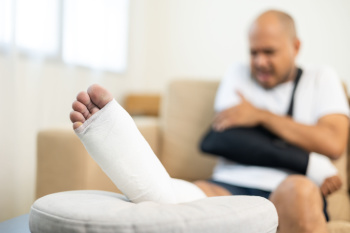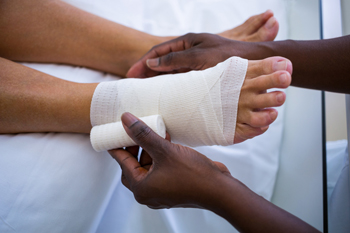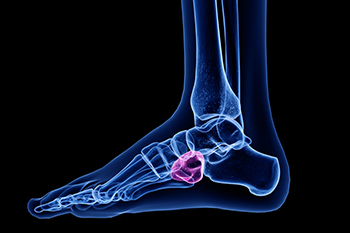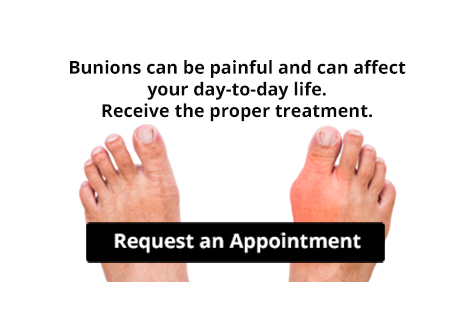Connect With Us
Blog
Items filtered by date: February 2025
What Causes Pain in the Ball of the Foot While Running?

Pain in the ball of the foot while running can be caused by various factors, including soft tissue injuries, bone injuries, and inflammation. Soft tissue injuries, such as strain or sprain of the muscles, tendons, or ligaments, can result in pain and swelling in the ball of the foot. Bone injuries, like metatarsal fractures or stress fractures, often cause sharp, localized pain that worsens with pressure. Inflammation in the area, such as bursitis or plantar metatarsalgia, can also lead to discomfort, with symptoms including swelling, redness, and increased sensitivity. The pain may worsen with activity, especially when running or standing for extended periods. If this type of foot pain is slowing you down while running, it is suggested that you promptly consult a podiatrist who can offer effective relief and treatment solutions.
Foot Pain
Foot pain can be extremely painful and debilitating. If you have a foot pain, consult with Scott Amoss, DPM from Advanced Foot & Ankle Specialists. our doctor will assess your condition and provide you with quality foot and ankle treatment.
Causes
Foot pain is a very broad condition that could be caused by one or more ailments. The most common include:
- Bunions
- Hammertoes
- Plantar Fasciitis
- Bone Spurs
- Corns
- Tarsal Tunnel Syndrome
- Ingrown Toenails
- Arthritis (such as Gout, Rheumatoid, and Osteoarthritis)
- Flat Feet
- Injury (from stress fractures, broken toe, foot, ankle, Achilles tendon ruptures, and sprains)
- And more
Diagnosis
To figure out the cause of foot pain, podiatrists utilize several different methods. This can range from simple visual inspections and sensation tests to X-rays and MRI scans. Prior medical history, family medical history, and any recent physical traumatic events will all be taken into consideration for a proper diagnosis.
Treatment
Treatment depends upon the cause of the foot pain. Whether it is resting, staying off the foot, or having surgery; podiatrists have a number of treatment options available for foot pain.
If you have any questions, please feel free to contact our offices located in Whiting and Toms River, NJ . We offer the newest diagnostic and treatment technologies for all your foot care needs.
Causes and Symptoms of Common Foot Fractures

Foot fractures can be painful and debilitating, with some more complex than others. Three common types include calcaneal fractures, Chopart fracture-dislocations, and metatarsal fractures. Calcaneal fractures, or heel bone fractures, usually result from high-impact injuries like falls or car accidents. They cause severe heel pain, swelling, and difficulty bearing weight. These fractures often require extensive recovery time and, in severe cases, surgery. Chopart fracture-dislocations affect the midfoot joint, often from high-energy trauma like twisting injuries or falls. This type of injury can be difficult to diagnose, leading to long-term instability if untreated. Symptoms include swelling, bruising, and difficulty walking. Metatarsal fractures involve the long bones in the foot and commonly occur from direct impact, overuse, or stress. Pain, swelling, and tenderness are typical signs. For proper healing and long-term mobility for any type of foot fracture, it is suggested that you see a podiatrist for a diagnosis and appropriate treatment.
A broken foot requires immediate medical attention and treatment. If you need your feet checked, contact Scott Amoss, DPM from Advanced Foot & Ankle Specialists. our doctor can provide the care you need to keep you pain-free and on your feet.
Broken Foot Causes, Symptoms, and Treatment
A broken foot is caused by one of the bones in the foot typically breaking when bended, crushed, or stretched beyond its natural capabilities. Usually the location of the fracture indicates how the break occurred, whether it was through an object, fall, or any other type of injury.
Common Symptoms of Broken Feet:
- Bruising
- Pain
- Redness
- Swelling
- Blue in color
- Numbness
- Cold
- Misshapen
- Cuts
- Deformities
Those that suspect they have a broken foot shoot seek urgent medical attention where a medical professional could diagnose the severity.
Treatment for broken bones varies depending on the cause, severity and location. Some will require the use of splints, casts or crutches while others could even involve surgery to repair the broken bones. Personal care includes the use of ice and keeping the foot stabilized and elevated.
If you have any questions please feel free to contact our offices located in Whiting and Toms River, NJ . We offer the newest diagnostic and treatment technologies for all your foot and ankle needs.
Are Bunions Affecting Your Everyday Life?
Off-Loading Practices for a Wounded Foot

Off-loading is essential for promoting healing in a wounded foot, as it reduces pressure on the affected area and prevents further damage. By redistributing weight away from the wound, off-loading minimizes pain, enhances blood flow, and accelerates tissue repair. Common methods include wearing specialized footwear, such as surgical shoes, total contact casts, or orthotic inserts, which cushion and protect the foot while allowing limited mobility. For severe wounds, crutches, knee scooters, or wheelchairs may be recommended to completely off-load weight. Regularly elevating the foot also helps reduce swelling and improve circulation. It is vital to keep weight off the wound to avoid reopening or worsening the injury. Proper off-loading techniques depend on the type, location, and severity of the wound. To ensure effective care and recovery, it is suggested that you consult a podiatrist for a personalized treatment plan.
Wound care is an important part in dealing with diabetes. If you have diabetes and a foot wound or would like more information about wound care for diabetics, consult with Scott Amoss, DPM from Advanced Foot & Ankle Specialists. our doctor will assess your condition and provide you with quality foot and ankle treatment.
What Is Wound Care?
Wound care is the practice of taking proper care of a wound. This can range from the smallest to the largest of wounds. While everyone can benefit from proper wound care, it is much more important for diabetics. Diabetics often suffer from poor blood circulation which causes wounds to heal much slower than they would in a non-diabetic.
What Is the Importance of Wound Care?
While it may not seem apparent with small ulcers on the foot, for diabetics, any size ulcer can become infected. Diabetics often also suffer from neuropathy, or nerve loss. This means they might not even feel when they have an ulcer on their foot. If the wound becomes severely infected, amputation may be necessary. Therefore, it is of the upmost importance to properly care for any and all foot wounds.
How to Care for Wounds
The best way to care for foot wounds is to prevent them. For diabetics, this means daily inspections of the feet for any signs of abnormalities or ulcers. It is also recommended to see a podiatrist several times a year for a foot inspection. If you do have an ulcer, run the wound under water to clear dirt from the wound; then apply antibiotic ointment to the wound and cover with a bandage. Bandages should be changed daily and keeping pressure off the wound is smart. It is advised to see a podiatrist, who can keep an eye on it.
If you have any questions, please feel free to contact our offices located in Whiting and Toms River, NJ . We offer the newest diagnostic and treatment technologies for all your foot care needs.
Cuboid Syndrome Facts

Cuboid syndrome is a condition that affects the cuboid bone, located on the outer side of the foot. This bone plays a key role in maintaining foot stability and mobility. The condition typically occurs when the cuboid bone becomes displaced or misaligned due to excessive stress or injury. The most common causes include ankle sprains, overuse, or repetitive movements that put strain on the foot. Symptoms of cuboid syndrome often include sharp pain on the outer side of the foot, difficulty bearing weight, swelling, and a feeling of instability while walking or running. In some cases, individuals may also experience tenderness when pressure is applied to the cuboid bone. To diagnose cuboid syndrome, a podiatrist will conduct a physical examination, focusing on foot movement of the affected area. X-rays or other imaging tests may be used to rule out fractures or other potential injuries. If you have pain on the outside of your foot, it is suggested that you contact a podiatrist who can accurately diagnose and treat cuboid syndrome.
Cuboid syndrome, also known as cuboid subluxation, occurs when the joints and ligaments near the cuboid bone in the foot become torn. If you have cuboid syndrome, consult with Scott Amoss, DPM from Advanced Foot & Ankle Specialists. our doctor will assess your condition and provide you with quality foot and ankle treatment.
Cuboid syndrome is a common cause of lateral foot pain, which is pain on the outside of the foot. The condition may happen suddenly due to an ankle sprain, or it may develop slowly overtime from repetitive tension through the bone and surrounding structures.
Causes
The most common causes of cuboid syndrome include:
- Injury – The most common cause of this ailment is an ankle sprain.
- Repetitive Strain – Tension placed through the peroneus longus muscle from repetitive activities such as jumping and running may cause excessive traction on the bone causing it to sublux.
- Altered Foot Biomechanics – Most people suffering from cuboid subluxation have flat feet.
Symptoms
A common symptom of cuboid syndrome is pain along the outside of the foot which can be felt in the ankle and toes. This pain may create walking difficulties and may cause those with the condition to walk with a limp.
Diagnosis
Diagnosis of cuboid syndrome is often difficult, and it is often misdiagnosed. X-rays, MRIs and CT scans often fail to properly show the cuboid subluxation. Although there isn’t a specific test used to diagnose cuboid syndrome, your podiatrist will usually check if pain is felt while pressing firmly on the cuboid bone of your foot.
Treatment
Just as the range of causes varies widely, so do treatments. Some more common treatments are ice therapy, rest, exercise, taping, and orthotics.
If you have any questions, please feel free to contact our offices located in Whiting and Toms River, NJ . We offer the newest diagnostic and treatment technologies for all your foot care needs.

